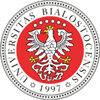Proszę używać tego identyfikatora do cytowań lub wstaw link do tej pozycji:
http://hdl.handle.net/11320/13023Pełny rekord metadanych
| Pole DC | Wartość | Język |
|---|---|---|
| dc.contributor.author | Szczepkowska-Flis, Agnieszka | - |
| dc.contributor.author | Kozłowska, Anna | - |
| dc.date.accessioned | 2022-04-11T08:03:00Z | - |
| dc.date.available | 2022-04-11T08:03:00Z | - |
| dc.date.issued | 2022 | - |
| dc.identifier.citation | Optimum. Economic Studies, Nr 1(107) 2022, s. 34-47 | pl |
| dc.identifier.issn | 1506-7637 | - |
| dc.identifier.uri | http://hdl.handle.net/11320/13023 | - |
| dc.description.abstract | Cel – Celem rozważań jest analiza zmian produktywności pracy w warunkach pandemii COVID-19 w kontekście Schumpeterowskiej koncepcji kreatywnej destrukcji i prac ekonomistów dotyczących roli innowacji i selekcji rynkowej w okresach kryzysów gospodarczych. Metoda badania – W teoretycznej części artykułu zastosowano metodę dedukcji. W warstwie empirycznej wykorzystano metody ekonometryczne (modele AR, ARDL) oraz metodę ewometrii. Wyniki – Zmiany produktywności pracy w okresie pandemii COVID-19 w gospodarce pozbawionej innowacji adaptacyjnych podlegałyby mechanizmom prostej destrukcji, prowadząc w długim okresie do jej stagnacji. Oryginalność/wartość/implikacje/rekomendacje – Koncepcja destrukcji kreatywnej tworzy alternatywne ramy teoretyczne dla interpretacji zmian produktywności obserwowanych w okresie pandemii COVID-19, otwierając obiecujący kierunek badań nad zachowaniem systemów gospodarczych w warunkach anormalnych. Zgodnie z zaproponowaną koncepcją interwencjonizm państwowy mający na celu ograniczenie rozprzestrzeniania się wirusa SARS-CoV-2 (lockdown) uruchamia innowacyjne działania dostosowawcze podmiotów, prowadzące do przekształcenia procesów typowych dla destrukcji prostej w destrukcję kreatywną. W kontekście koncepcji destrukcji kreatywnej warunkiem koniecznym zainicjowania pokryzysowego wzrostu jest polityka promowania innowacji już w trakcie kryzysu COVID-19, warunkiem wystarczającym natomiast jest oparcie pomocy państwa na kryterium powiązanym z efektywnością. | pl |
| dc.description.abstract | Purpose – The aim of the article is to analyse changes in labour productivity during the COVID-19 pandemic in the context of Schumpeter’s concept of creative destruction and the work of economists on the role of innovation and market selection during economic crises. Research method – In the theoretical part of the article the method of deduction was used. In the empirical layer, econometric methods (AR, ARDL models) and the evometrics were used. Results – Changes in labour productivity during the COVID-19 pandemic in an economy devoid of adaptive innovations would be subject to mechanisms of simple destruction, leading to its stagnation in the long run. Originality /value /implications /recommendations – The concept of “destruction which brings creation” provides an alternative theoretical framework for interpreting the productivity changes during the COVID-19 pandemic, opening up a promising avenue for studying the behaviour of economic systems in abnormal conditions. According to our concept, state intervention aimed at limiting the spread of the SARS-CoV-2 virus (lockdown) triggers innovative adaptation activities of entities leading to the transformation of processes typical for simple destruction into destruction which brings creation. In the context of our concept, a policy of promoting innovation already during the COVID-19 crisis is a necessary condition, and the inclusion of the efficiency criterion in state aid is a sufficient condition for initiating post-crisis growth. | pl |
| dc.language.iso | pl | pl |
| dc.publisher | Wydawnictwo Uniwersytetu w Białymstoku | pl |
| dc.subject | kreatywna destrukcja | pl |
| dc.subject | produktywność pracy | pl |
| dc.subject | pandemia COVID-19 | pl |
| dc.subject | creative destruction | pl |
| dc.subject | labour productivity | pl |
| dc.subject | COVID-19 pandemic | pl |
| dc.title | Zmiany produktywności w okresie kryzysu COVID-19 w świetle Schumpeterowskiej koncepcji kreatywnej destrukcji | pl |
| dc.title.alternative | Productivity changes during the COVID-19 crisis in the light of the Schumpeterian concept of creative destruction | pl |
| dc.type | Article | pl |
| dc.rights.holder | © Copyright by Uniwersytet w Białymstoku | pl |
| dc.identifier.doi | 10.15290/oes.2022.01.107.03 | - |
| dc.description.Email | Agnieszka Szczepkowska-Flis: agawik.flis@op.pl | pl |
| dc.description.Email | Anna Kozłowska: anna.kozlowska@ue.poznan.pl | pl |
| dc.description.Affiliation | Agnieszka Szczepkowska-Flis - Instytut Prawa i Ekonomii, Uniwersytet Kazimierza Wielkiego w Bydgoszczy | pl |
| dc.description.Affiliation | Anna Kozłowska - Instytut Ekonomii, Uniwersytet Ekonomiczny w Poznaniu | pl |
| dc.description.references | Abdi H., Molin P., 2007, Lilliefors/Van Soest’s Test of Normality, [w:] Encyclopedia of Measurement and Statistics, Salkind N.J. (ed.), SAGE Publications, Thousand Oaks, pp. 540–544. | pl |
| dc.description.references | Andersen E.S., 2004. Evolutionary Econometrics: From Joseph Schumpeter’s Failed Econometrics to George Price’s General Evometrics and Beyond, www.business.aau.dk/evolution/esapapers/esa04/evometrics.pdf [data dostępu: 30.05.2006]. | pl |
| dc.description.references | Askenazy P., Erhel C., 2015, The French Productivity Puzzle, “IZA Discussion Paper”, no. 9188, pp. 1–42. | pl |
| dc.description.references | Baily, M.N., Bartelsman, E.J., Haltiwanger J., 2001, Labor Productivity: Structural Change and Cyclical Dynamics, “Review of Economics and Statistics”, vol. 83, no. 3, pp. 420–433, DOI: 10.1162/00346530152480072. | pl |
| dc.description.references | Baldwin J.R., Gu W., 2002, Plant Turnover and Productivity Growth in Canadian Manufacturing, “OECD Science, Technology and Industry Working Papers”, no. 2, pp. 1–47, DOI: 10.1787/745662258480. | pl |
| dc.description.references | Baltagi B., 2011, Econometrics, Springer-Verlag, Berlin Heidelberg. | pl |
| dc.description.references | Bartelsman E.J., Dhrymes P.J., 1998, Productivity Dynamics: U.S. Manufacturing Plants, 1972–1986, “Journal of Productivity Analysis”, vol. 9, no. 1, pp. 5–34, DOI: 10.1023/A:1018383629341. | pl |
| dc.description.references | Bennett D.L., 2021, Local Economic Freedom and Creative Destruction in America, “Small Business Economics “, vol. 56, pp. 333–353, DOI: 10.1007/s11187-019-00222-0. | pl |
| dc.description.references | Bosio E., Djankov S., Jolevski F., Ramalho R., 2020, Survival of Firms During Economic Crisis, “World Bank Policy Research Working Papers”, no. 9239, pp. 1–27, https://ssrn.com/abstract=3599546, [data dostępu: 10.07.2021], DOI: 10.1596/1813-9450-9239. | pl |
| dc.description.references | Davidson R., MacKinnon J.G., 1999, Foundations of Econometrics, Oxford Press, London. | pl |
| dc.description.references | di Mauro F., Syverson C., 2020, The COVID Crisis and Productivity Growth, “Becker Friedman Institute White Papers”, pp. 1–6, https://bfi.uchicago.edu/wp-content/uploads/BFI_White-Paper_Syverson_6.2020.pdf [data dostępu: 15.07.2020]. | pl |
| dc.description.references | Dieppe A., Matsuoka H., 2020, Sectoral Sources of Productivity Growth, [w:] Global Productivity. Trends, Drivers, and Policies, Dieppe A. (red), World Bank, Washington, pp. 357–389, DOI: 10.1596/978-1-4648-1608-6_ch7. | pl |
| dc.description.references | Erixon L., 2016, Is Firm Renewal Stimulated by Negative Shocks? The Status of Negative Driving Forces in Schumpeterian and Darwinian Economics, “Cambridge Journal of Economics”, vol. 40, no. 1, pp. 93–121, DOI: 10.1093/cje/beu068. | pl |
| dc.description.references | Faccio M., McConnell J.J., 2020, Impediments to the Schumpeterian Process in the Replacement of Large Firms, “NBER Working Papers”, no. 27871, pp. 1–60, DOI: 10.2139/ssrn.3700699. | pl |
| dc.description.references | Foster L., Haltiwanger J., Krizan C.J., 2002, The Link Between Aggregate and Micro Productivity Growth: Evidence from Retail Trade, “NBER Working Papers”, no. 9120, pp. 1–62, DOI: 10.3386/W9120. | pl |
| dc.description.references | Foster L., Haltiwanger J., Syverson C., 2008, Reallocation, Firm Turnover, and Efficiency: Selection on Productivity or Profitability?, “American Economic Review”, vol. 98, no. 1, pp. 394–425, DOI: 10.1257/aer.98.1.394. | pl |
| dc.description.references | Geroski P.A., 1989, Entry, Innovation and Productivity Growth, “Review of Economics and Statistics”, vol. 71, no. 4, pp. 572–578, DOI: 10.2307/1928098. | pl |
| dc.description.references | Greene W.H., 2012, Econometric Analysis, Pearson Education, Upper Saddle River. | pl |
| dc.description.references | Griliches Z., Regev H., 1992, Productivity and Firm Turnover in Israeli Industry: 1979–1988, “NBER Working Papers”, no. 4059, s. 1–37, DOI: 10.3386/w4059. | pl |
| dc.description.references | Gujarati D.N., 2004, Basic Econometrics, McGraw-Hill, New York. | pl |
| dc.description.references | Hill R.C., Griffiths W.E., Lim G.C., 2011, Principles of Econometrics, John Wiley & Sons, New York. | pl |
| dc.description.references | Johnston J., DiNardo J., 1997, Econometric Methods, McGraw Hill, New York. | pl |
| dc.description.references | Kılınç U., 2018, Productivity Slowdown and Missallocation in the Post-Recession: What Prevents Recovery?, “Journal of Technology Transfer”, vol. 43, no. 6, pp. 1542–1570, DOI: 10.1007/s10961-016-9541-0. | pl |
| dc.description.references | Lee H.N., Lee J.-D., Beak C., 2017, Productivity Dynamics and the Cleansing Effect of Two Recessions: Evidence from the Manufacturing Sector in Korea, “Pacific Economic Review”, vol. 22, no. 4, pp. 677–701, DOI: 10.1111/1468-0106.12239. | pl |
| dc.description.references | Levinsohn J., Petropoulos W., 2001, Creative Destruction or Just Plain Destruction?: The U.S. Textile and Apparel Industries since 1972, “NBER Working Papers”, no. 8348, pp. 1–36, DOI: 10.3386/w8348. | pl |
| dc.description.references | Levinthal D.A., 1998, The Slow Pace of Rapid Technological Change: Gradualism and Punctuation in Technological Change, “Industrial and Corporate Change”, vol. 7, No. 2, pp. 217–247, DOI: 10.1093/icc/7.2.217. | pl |
| dc.description.references | Market Dynamics and Productivity in Developing Countries. Economic Reforms in the Middle East and North Africa, 2010, Sekkat K. (red.), Springer-Verlag, New York, DOI: 10.1007/978-1-4419-1037-0. | pl |
| dc.description.references | Ouyang M., 2009, The Scarring Effect of Recessions, “Journal of Monetary Economics”, vol. 56(2), pp. 184–199, DOI: 10.1016/j.jmoneco.2008.12.014. | pl |
| dc.description.references | Peters M., Walsh C., 2019, Declining Dynamism, Increasing Markups and Missing Growth: The Role of the Labor Force, “2019 Meeting Papers”, no. 658, Society for Economic Dynamics, DOI: 10.2139/ssrn.3493284. | pl |
| dc.description.references | Schumpeter, J.A., 1960, Teoria rozwoju gospodarczego, PWN, Warszawa. | pl |
| dc.description.references | Sinagl P., Wang J., 2021, To Innovate or not to Innovate when times are bad, https://papers.ssrn.com/sol3/papers.cfm?abstract_id=3761498 [data dostępu: 7.07.2021]. | pl |
| dc.description.references | ter Wengel J., Rodriguez E.R., 2006, Productivity and Firm Dynamics: Creative Destruction in Indonesian Manufacturing, 1994–2000, “Bulletin of Indonesian Economic Studies”, vol. 42, no. 3, pp. 341–355, DOI: 10.1080/00074910601053219. | pl |
| dc.description.references | Troske K.R., 1996, The Dynamic Adjustment Process of Firm Entry and Exit in Manufacturing and Finance, Insurance, and Real Estate, “Journal of Law and Economics”, vol. 39, no. 2, pp. 705–735, DOI: 10.1086/467363. | pl |
| dc.description.references | Verbeek M., 2004, A Guide to Modern Econometrics, John Wiley & Sons, London. | pl |
| dc.description.references | Yaşar M., Rejesus R.M., Mintemur I., 2004, Is There Evidence of Creative Destruction in the Turkish Manufacturing Sector? Lessons from a Cross-Industry Analysis of Aggregate Productivity Growth, “Applied Economics”, vol. 36, no. 17, pp. 1927–1945, DOI: 10.1080/000368404200068610. | pl |
| dc.description.number | 1(107) | pl |
| dc.description.firstpage | 34 | pl |
| dc.description.lastpage | 47 | pl |
| dc.identifier.citation2 | Optimum. Economic Studies | pl |
| dc.identifier.orcid | 0000-0003-3946-426X | - |
| dc.identifier.orcid | 0000-0002-2527-3641 | - |
| Występuje w kolekcji(ach): | Optimum. Economic Studies, 2022, nr 1(107) | |
Pliki w tej pozycji:
| Plik | Opis | Rozmiar | Format | |
|---|---|---|---|---|
| Optimum_1_2022_A_Szczepkowska_Flis_A_Kozlowska_Zmiany_produktywnosci.pdf | 269,71 kB | Adobe PDF | Otwórz |
Pozycja jest chroniona prawem autorskim (Copyright © Wszelkie prawa zastrzeżone)

